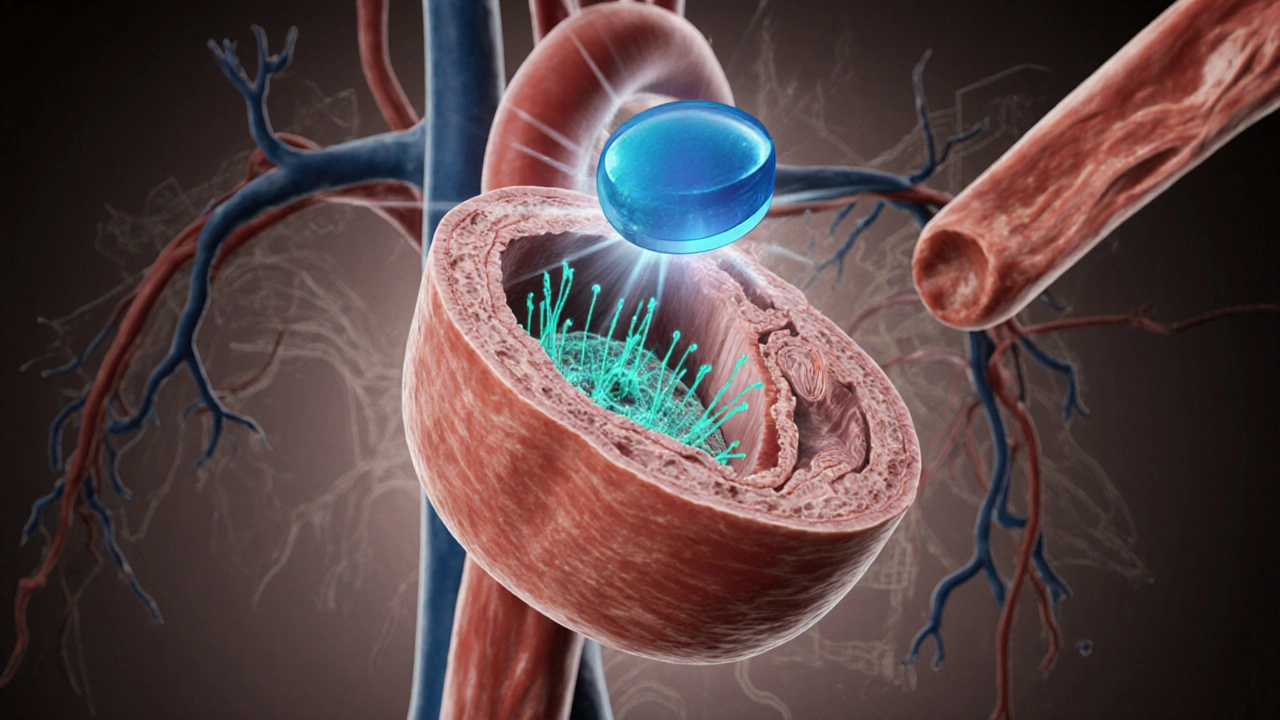Cardizem (Diltiazem) vs. Other Calcium Channel Blockers: Benefits, Risks & Choosing the Right Option

Calcium Channel Blocker Selector
Cardizem
(Diltiazem)
Non-dihydropyridine
AV node blocker
Norvasc
(Amlodipine)
Dihydropyridine
Vasodilator
Calan
(Verapamil)
Non-dihydropyridine
Strong cardiac effect
Procardia
(Nifedipine)
Dihydropyridine
Vasodilator
Recommended Choice for Selected Condition
Select a condition above to see personalized recommendations
Key Differences Summary
Cardizem (Diltiazem): Best for patients needing both blood pressure control and heart rhythm regulation. Non-dihydropyridine with AV node effects.
Amlodipine: Ideal for straightforward hypertension or angina. Dihydropyridine causing more peripheral edema.
Verapamil: Strong cardiac effect, excellent for rate control in atrial fibrillation but with higher constipation risk.
Nifedipine: Effective for hypertension and Raynaud's disease. Extended-release preferred for chronic therapy.
Key Takeaways
- Cardizem (diltiazem) is a non‑dihydropyridine calcium channel blocker used for hypertension, angina, and certain heart rhythm disorders.
- Its main alternatives - amlodipine, verapamil and nifedipine - belong to the same drug class but differ in selectivity, side‑effect profiles and dosing convenience.
- When choosing a medication, consider the specific condition (high blood pressure vs. angina vs. atrial fibrillation), patient age, liver function and potential drug interactions.
- Common side effects across the class include swelling, headache and dizziness, but verapamil carries a higher risk of constipation and heart‑block, while amlodipine often causes peripheral edema.
- Cost and formulation (immediate‑release vs. extended‑release) can influence adherence; generic diltiazem is usually affordable, but some alternatives may be cheaper in certain regions.
What is Cardizem (Diltiazem)?
When you see the name Cardizem (Diltiazem) is a non‑dihydropyridine calcium channel blocker that relaxes blood‑vessel walls and slows electrical conduction in the heart. It was first approved by the FDA in 1990 and quickly became a go‑to option for treating high blood pressure, chronic stable angina and certain types of supraventricular tachycardia, especially atrial fibrillation.
Diltiazem works by blocking L‑type calcium channels in both vascular smooth muscle and cardiac nodal tissue. This dual action lowers blood pressure and reduces the heart’s workload, while also helping to control abnormal heart rhythms.
How Calcium Channel Blockers Fit Into Heart Care
The broader class, calcium channel blockers are medications that inhibit calcium entry into cells, leading to vasodilation and decreased cardiac contractility. They are split into two sub‑families:
- Dihydropyridines - mainly affect blood vessels (e.g., amlodipine, nifedipine).
- Non‑dihydropyridines - affect both vessels and heart conduction (e.g., diltiazem, verapamil).
Understanding this split helps explain why diltiazem feels different from amlodipine or nifedipine in clinical practice.
Top Alternatives to Cardizem
Below is a side‑by‑side look at the most common substitutes. The table focuses on the attributes most patients and prescribers ask about.
| Brand / Generic | Mechanism | Primary Indications | Typical Dosage Form | Common Side Effects | Approx. Monthly Cost (US$) |
|---|---|---|---|---|---|
| Cardizem (Diltiazem) | Non‑dihydropyridine calcium‑channel block | Hypertension, angina, atrial fibrillation | Extended‑release tablet 30‑180mg | Swelling, headache, bradycardia | 15‑30 |
| Norvasc (Amlodipine) | Dihydropyridine calcium‑channel block | Hypertension, chronic angina | Immediate‑release tablet 5‑10mg | Peripheral edema, flushing, dizziness | 10‑20 |
| Calan (Verapamil) | Non‑dihydropyridine calcium‑channel block (stronger cardiac effect) | Hypertension, angina, rate control in AF | d>Extended‑release tablet 120‑240mgConstipation, bradycardia, AV block | 12‑25 | |
| Procardia (Nifedipine) | Dihydropyridine calcium‑channel block | Hypertension, Raynaud’s, angina | Extended‑release tablet 30‑90mg | Headache, flushing, tachycardia | 8‑15 |
When to Choose Cardizem Over the Others
If your doctor is tackling more than just high blood pressure-say, you have occasional atrial fibrillation episodes-the dual action of diltiazem often wins out. It slows conduction through the AV node, which beta‑blockers or pure vasodilators can’t do as effectively.
Patients with liver impairment may need dose adjustments, because diltiazem is metabolized by CYP3A4. In contrast, amlodipine has a longer half‑life and fewer drug‑interaction worries, making it a safer bet for polypharmacy.
Older adults who experience significant peripheral swelling on amlodipine sometimes tolerate diltiazem better, as the latter’s edema rate is lower, though they should still be monitored for bradycardia.
Side Effects, Interactions & Precautions
All calcium channel blockers share a core set of adverse events-headache, dizziness, and mild swelling. However, each agent adds its own quirks:
- Cardizem: Watch for slow heart rate, especially when combined with beta‑blockers or digoxin.
- Amlodipine: Peripheral edema can be pronounced; using a low‑salt diet helps.
- Verapamil: Constipation is common; increase fiber intake.
- Nifedipine: Rapid‑release forms can cause sudden drops in blood pressure-always use the extended‑release version for chronic therapy.
Key drug‑interaction culprits include:
- CYP3A4 inhibitors (e.g., ketoconazole, grapefruit juice) - raise diltiazem levels.
- Other heart‑rate‑slowing drugs - increase risk of AV block.
- NSAIDs - may blunt antihypertensive effect.
Pregnant women should avoid diltiazem unless clearly needed; amlodipine is category C, while verapamil is also used with caution.

Practical Tips for Patients
- Take the extended‑release tablet with food to lessen stomach upset.
- Never crush or chew; it changes the release profile.
- Check blood pressure and pulse regularly-document both for your clinician.
- If you miss a dose, take it as soon as you remember unless it’s near the next scheduled dose; then skip the missed one.
- Store at room temperature, away from moisture.
Frequently Asked Questions
Can I switch from Cardizem to amlodipine without a doctor’s notice?
No. Although both lower blood pressure, they differ in heart‑rate effects. A medical professional should evaluate your condition, adjust the dose and monitor for side effects during the switch.
Is Cardizem safe for people with asthma?
Generally, yes. Diltiazem does not directly affect bronchial smooth muscle, but high doses can cause mild reflex tachycardia that might worsen asthma symptoms. Discuss any breathing issues with your clinician.
What should I do if I experience severe swelling on Cardizem?
Contact your healthcare provider promptly. Swelling (edema) can signal fluid retention that may need dose reduction or a switch to another class, such as an ACE inhibitor combined with a lower dose calcium blocker.
Does Cardizem interact with statins?
Some statins (e.g., simvastatin, atorvastatin) share the CYP3A4 pathway. When taken together, diltiazem can raise statin levels, increasing muscle‑pain risk. Your doctor may choose a statin not metabolized by CYP3A4 or adjust the dose.
How quickly does Cardizem start working?
The extended‑release formulation begins to lower blood pressure within 2‑4 hours, reaching steady‑state effects after about 3‑5 days of consistent dosing.
Bottom Line: Making an Informed Choice
Choosing the right heart medication isn’t about picking the cheapest pill; it’s about matching a drug’s pharmacology to your specific health picture. Cardizem shines when you need both blood‑pressure control and rhythm management, especially in patients with occasional atrial fibrillation. If your main goal is simple hypertension without rhythm concerns, amlodipine’s once‑daily dosing and lower interaction risk may be more convenient.
Always involve your prescriber in the decision, review your full medication list, and monitor how you feel after any change. With the right fit, you’ll keep blood pressure in check, avoid unwanted side effects, and stay on top of your heart health.

10 Comments
Okay, this post is basically a copy‑paste of a pharma brochure, but at least they nailed the jargon about non‑dihydropyridines. I’ve seen better UI design on a toaster, yet the drug info is surprisingly spot‑on. Just don’t expect any deep pharmacodynamic analysis here.
While the overview is thorough, the assertion that diltiazem is the optimal choice for mixed conditions appears overstated.
Great summary! 👍 The side‑effect breakdown really helps when you’re juggling multiple meds. 🌟
Reading this, I can’t help but feel the unseen forces are subtly guiding us toward a pharmaceutical agenda; the way Cardizem is glorified reads like a script written by shadowy lobbyists, ships of the line in the grand ocean of cardiovascular control. The author conveniently glosses over the fact that every calcium channel blocker is a pawn in the larger game of profit‑driven medicine, a truth hidden behind glossy tables and friendly UI widgets. One must question why the side‑effect profile of diltiazem is presented with such a benign tone, as if edema were merely a gentle breeze rather than a sign of fluid retention that could betray deeper renal compromise. Have you ever noticed the subtle omission of the long‑term mortality data, the silent footnotes buried in the FDA filings that rarely see daylight? Perhaps the true mastermind behind this narrative is the conglomerate that manufactures extended‑release tablets, keen to push a product that ensures a steady stream of revenue. Moreover, the interplay between CYP3A4 inhibition and statin metabolism is brushed aside, a detail that could spell muscle toxicity in unsuspecting patients. This omission is not accidental; it is a calculated move to keep the layperson satisfied while the hidden costs accumulate. The recommendation engine that highlights Cardizem for atrial fibrillation feels like a whispering echo of a clinical trial sponsored by the same brand-a classic case of conflict of interest. Even the choice of colors in the UI, the soothing blues, may be designed to calm the reader, reducing critical scrutiny. It is as if the interface itself participates in the seduction, lulling the audience into a false sense of safety. One must also consider the geopolitical implications: the drug’s affordability in developing nations is touted, yet the pricing strategies in wealthy markets remain opaque, a classic example of price discrimination. The very fact that the post mentions “generic diltiazem is usually affordable” while neglecting the patent extensions on newer formulations raises eyebrows. Are we, the readers, being subtly nudged toward a particular therapeutic pathway, while alternative non‑pharmacologic interventions like lifestyle modification are relegated to footnotes? The subtlety of this persuasion is masterful, yet it is a reminder that every piece of medical literature is a battleground. In the end, the truth lies in the gaps-what is not said is often more powerful than what is explicitly stated.
Honestly, the piece does a solid job breaking down the pros and cons without overcomplicating things; I’d stick with the vibe it gives.
Behold, the saga of calcium channel blockers unfolds like a tragic opera, each drug a character dancing on the precipice of efficacy and peril! Diltiazem takes the center stage with a heart‑thumping rhythm, while Amlodipine flutters in like a delicate butterfly-only to cascade into swelling that drapes the limbs like velvet chains! Verapamil, the brooding poet, whispers constipatory verses in the gut, and Nifedipine erupts in a flaming blaze of tachycardic fireworks! The author’s tabular presentation is a canvas painted with hues of hope and dread-truly a masterpiece of medical melodrama!
The recommendation seems biased toward Cardizem, which I find questionable.
I think the comparison is useful and balanced overall
Ths post hlps me undrstand differebnt meds and wht to watc for side effects
Keep up the good work its clear an informativ guide for many patients